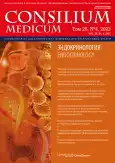Methods for determining iodine in urine
- Authors: Nikankina L.V.1, Zuraeva Z.T.1, Troshina E.A.1
-
Affiliations:
- National Medical Research Center for Endocrinology
- Issue: Vol 25, No 4 (2023): Endocrinology
- Pages: 267-273
- Section: Articles
- URL: https://journals.rcsi.science/2075-1753/article/view/131669
- DOI: https://doi.org/10.26442/20751753.2023.4.202276
- ID: 131669
Cite item
Full Text
Abstract
Iodine deficiency remains a serious threat to public health worldwide, especially in children and pregnant women. Despite the apparent ease of iodine deficiency elimination with the help of a simple and highly effective strategy of compulsory salt iodization, the problem of iodine deficiency and iodine deficiency disorders remains urgent for public health in the Russian Federation. The most effective and informative way to study iodine status at population level is determination of iodine concentration in urine in epidemiological studies. This article presents a review of urinary iodine determination methods, as well as methodological recommendations for iodine determination, developed and adopted in National Medical Research Center for Endocrinology.
Full Text
##article.viewOnOriginalSite##About the authors
Larisa V. Nikankina
National Medical Research Center for Endocrinology
Email: Zuraeva.Zamira@endocrincentr.ru
ORCID iD: 0000-0002-1120-8240
SPIN-code: 2794-0008
Cand. Sci. (Med.)
Russian Federation, MoscowZamira T. Zuraeva
National Medical Research Center for Endocrinology
Author for correspondence.
Email: Zuraeva.Zamira@endocrincentr.ru
ORCID iD: 0000-0001-6953-6928
SPIN-code: 6002-0455
Cand. Sci. (Med.)
Russian Federation, MoscowEkaterina A. Troshina
National Medical Research Center for Endocrinology
Email: troshina@inbox.ru
ORCID iD: 0000-0002-8520-8702
D. Sci. (Med.), Prof., Acad. RAS
Russian Federation, MoscowReferences
- World Health Organization/International Council for the Control of the Iodine Deficiency Disorders/United Nations Childrens Fund (WHO/ICCIDD/UNICEF). Assessment of the iodine deficiency disorders and monitoring their elimination. Geneva: World Health Organization, 2007.
- Абдулхабирова Ф.М., Безлепкина О.Б., Бровин Д.Н., и др. Клинические рекомендации «Заболевания и состояния, связанные с дефицитом йода». Проблемы эндокринологии. 2021;67(3):10-25 [Abdulkhabirova FM, Bezlepkina OB, Brovin DN, et al. Clinical practice guidelines “Management of iodine deficiency disorders”. Problems of Endocrinology. 2021;67(3):10-25 (in Russian)]. doi: 10.14341/probl12750
- Salarkia N, Hedayati M, Mirmiran P, et al. Evaluation of the impact of an iodine supplementation programme on severely iodine-deficient schoolchildren with hypothyroidism. Public Health Nutr. 2003;6(6):529-33. doi: 10.1079/phn2003471
- Vermiglio F, Lo Presti VP, Moleti M, et al. Attention deficit and hyperactivity disorders in the offspring of mothers exposed to mild-moderate iodine deficiency: a possible novel iodine deficiency disorder in developed countries. J Clin Endocrinol Metab. 2004;89(12):6054-60. doi: 10.1210/jc.2004-0571
- Delange F. Iodine deficiency as a cause of brain damage. Postgrad Med J. 2001;77(906):217-20. doi: 10.1136/pmj.77.906.217
- Zimmermann MB, Jooste PL, Pandav CS. Iodine-deficiency disorders. Lancet. 2008;372(9645):1251-62. doi: 10.1016/S0140-6736(08)61005-3
- Hurrell RF. Bioavailability of iodine. Eur J Clin Nutr. 1997;51 Suppl. 1:S9-12.
- Sandell EB, Kolthoff IM. Micro determination of iodine by a catalytic method. Mikrochemica Acta. 1937;1:9-25. doi: 10.1007/BF01476194
- Haldimann M, Zimmerli B, Als C, Gerber H. Direct determination of urinary iodine by inductively coupled plasma mass spectrometry using isotope dilution with iodine-129. Clin Chem. 1998;44(4):817-24.
- Арбузова М.И., Махмудов А.А., Герасимов Г.А., Ильин А.В. Микрометод определения йода в моче. Клиническая и экспериментальная эндокринология. 2007;3(2):15-8 [Arbuzova MI, Makhmudov AA, Gerasimov GA, Ilyin AV. Micromethod of Iodine Measurement in Urine. Klinicheskaia i eksperimentalnaia endokrinologiia. 2007;3(2):15-8 (in Russian)].
- Ohashi T, Yamaki M, Pandav CS, et al. Simple microplate method for determination of urinary iodine. Clin Chem. 2000;46(4):529-53.
- Руководство по методам контроля качества и безопасности биологически активных добавок к пище. Руководство. Р 4.1.1672-03 (утв. Главным государственным санитарным врачом РФ 30.06.2003). Режим доступа: https://lawrussia.ru/bigtexts/law_561/index.htm. Ссылка активна на 09.06.2023 [Guidance on methods of quality control and safety of biologically active food supplements. Management. R 4.1.1672-03 (approved by the Chief State Sanitary Doctor of the Russian Federation on June 30, 2003). Available at: https://lawrussia.ru/bigtexts/law_561/index.htm. Accessed: 09.06.2023 (in Russian)].
- Определение йода в соли поваренной пищевой, йодированной йодатом калия (KIO3). Методические указания. Мук 4.1.699-98 (утв. Минздравом РФ 14.04.1998). Разработаны Институтом питания РАМН (В.А. Тутельян, В.Б. Спиричев, О.Г. Переверзева) на основе официально принятого международными организациями ВОЗ, ЮНИСЕФ, РАММ, МИ, ICCIDD руководства «Мониторинг программ всеобщего йодирования соли». М., 1997. Режим доступа: https://lawrussia.ru/texts/legal_216/doc216a242x159.htm. Ссылка активна на 09.06.2023 [Determination of iodine in table salt iodized with potassium iodate (KIO3). Methodical instructions. Muk 4.1.699-98 (approved by the Ministry of Health of the Russian Federation on April 14, 1998). Developed by the Institute of Nutrition of the Russian Academy of Medical Sciences (VA Tutelyan, VB Spirichev, OG Pereverzeva) on the basis of the guidelines “Monitoring of universal salt iodization programs” officially adopted by international organizations WHO, UNICEF, RAMM, MI, ICCIDD. Moscow, 1997. Available at: https://lawrussia.ru/texts/legal_216/doc216a242x159.htm. Accessed: 09.06.2023 (in Russian)].
Supplementary files







